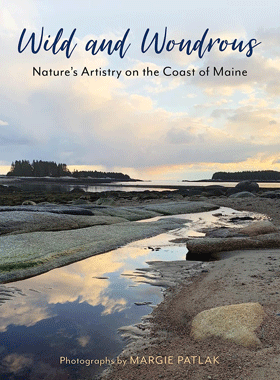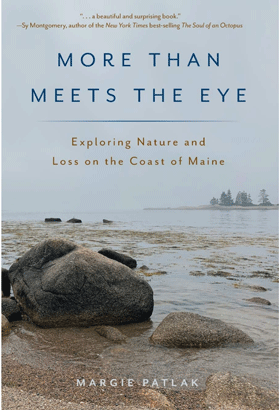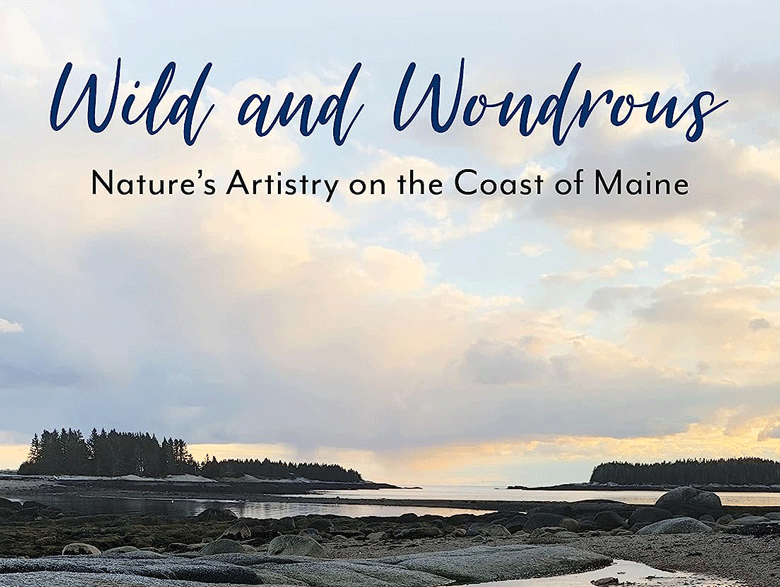More Than Meets the Eye: Exploring Nature and Loss on the Coast of Maine
By Margie Patlak, Down East Books (2021)
Wild and Wondrous: Nature’s Artistry on the Coast of Maine
By Margie Patlak, Down East Books (2023)
Dust off your copy of Margie Patlak’s book, More Than Meets the Eye: Exploring Nature and Loss on the Coast of Maine and have it handy when her next book, Wild and Wondrous: Nature’s Artistry on the Coast of Maine is published this summer. The two really are companion pieces describing the natural world of the Schoodic Peninsula region.

While each can stand alone, the newest book—a collection of her photographs organized thematically in chapters with short introductions by the author—nicely illustrates the first. I imagine other readers might have reacted as I did while reading More Than Meets the Eye: “Where are the pictures? This must look amazing!”
In a way, the point of that book was not to see the text illustrated, but rather to feel an experience as Patlak did, that being in that landscape and grieving the loss of two close family members over several years became interwoven, one informing the other. Patlak’s home and environs in Corea and the Schoodic Peninsula served to sponsor pondering the meaning of life and loss.
She is a curious observer and relentless researcher. More Than Meets the Eye is not only emotionally informed and deeply personal, but benefits from the author’s background in botany and environmental studies, and her ongoing writing about the environment, neuroscience, technology, and biomedical research for popular science publications.
Each chapter focuses on a particular aspect of the Schoodic area, among them fog, flora and fauna, rocks and geology, clouds, and tides.
More Than Meets the Eye is not only emotionally informed and deeply personal, but benefits from the author’s background…
Throughout the book, a life event is connected to the broader phenomenon under discussion. For instance, the chapter, “They Say There Are Moose,” refers to (her) difficulty in actually seeing one, despite their size and that she lives in moose terrain and others have sighted them. It’s left Patlak frustrated and disappointed. But she conveys some fascinating facts, including mating behaviors and how they are drawn to swimming and going underwater, not only to eat aqueous plants but to cool off.
A scorcher of a summer day she’d endured there is described, too hot to do much of anything. She’d used the downtime to read Moose by Valerius Geist, then refreshed herself in the frigid bay with a bracing swim.
In bed that night—still warm with windows left wide open—she heard a noise, “a tremendous splashing in the water followed by loud snorting… I realize what I’ve just heard. A moose.” Heard, but not seen.
Explaining tides, Patlak describes how she learned to adapt her own schedule to that of the moon’s. If she wants to kayak or swim, then she needed to be free at high tide. To collect sea glass or stones, she awaits low tide.

The tyranny of the tidal clock shaping her day and activities may seem a harsh lesson in ceding control. But she finds ways to take comfort in accepting that, comparing it to her becoming a mother whose parenting of children has to take into account their diminished need for that, even when she might wish otherwise. And there is opportunity in the lesson of tides to feel connected to a profound rhythm of life. She quotes poet Mary Oliver: “In water that departs forever and forever returns, we experience eternity.”
Wild and Wondrous includes Patlak’s poetic musings on nature as well. Fog, for example, is described as “particularly emblematic of coastal Maine… It imparts a dreaminess to the landscape that makes you question what’s there and what isn’t, what is real and what is a mirage…”.
That chapter’s photographs and the ones in “Reflections” and “Intersections and Tides” are probably my favorites, though it was fun to see portraits of some wildlife she’d written about in More Than Meets the Eye. (Of course, no moose!)
While Wild and Wondrous has the makings of a coffee table book or the perfect souvenir or house gift, I appreciate it most in combination with More Than Meets the Eye. Patlak brings the reader through a life-changing event in that first book, grieving the deaths of her mother and brother. In reorienting herself to that loss, she took an inventory of where she is and what she has. Wild and Wondrous documents that outcome—becoming re-grounded, as it were.
Tina Cohen is a therapist who splits her time between Massachusetts and Vinalhaven.





